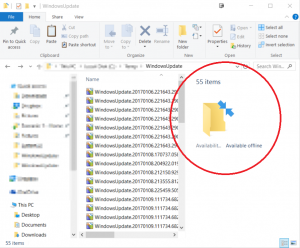Group policies can be applied selectively to specific devices with the help of groups. Utilising this, it is possible to phase-in group policies, over a period of time, by randomly adding non-members user or computers at a set interval, to a group filtering a group policy.
Introduction
Some settings, especially security related, are postponed indefinitely because no built in phase-in mechanism exists. Sure you can apply a GPO via a group but you have to remember to keep adding members to it and even then, you will
probably not add members in randomly. The process below tackles these issues by automating the GPO phase-in process.
Please note: The process below is intended to be configured on the group that is configured as a security filter on a GPO
Implementation
1) Download and extract ADRandomAddToGroup.zip (here is VirusTotal scan) to a folder of your choice, on the computer which it will be scheduled to run on.
2) Get group DN
3) Run Configurator.exe (Configurator Editor).
All configuration is stored within the ADRandomAddToGroup.ConsoleApp.exe file and can be either edited directly or with my Configuration Editor tool.
a) On the Settings tab, enter the Group’s distinguished name (DN), recorded in Step 2.
b) Configure whether users or computers should be randomly added, and how many to add at a time. For this example, users are added randomly, five at a time.
c) On the userExcludedDNs tab, add distinguished names of OUs that contains objects that should never be added to this group. (Use +/-/Insert/Delete/Spacebar to manage entries.)
d) On the userIncludedDNs tab, add distinguished names of OUs that contains objects that should be added to this group. (Use +/-/Insert/Delete/Spacebar to manage entries.)
e) Similarly, included and excluded distinguished names can be configured for computer objects.
f) Save the configuration file and close Configuration Editor.
This is how the XML file look for the above setting if you choose to edit it manually.
<?xml version="1.0" encoding="utf-8"?> <configuration> <configSections> <section name="userExcludedDNs" type="System.Configuration.NameValueSectionHandler" /> <section name="userIncludedDNs" type="System.Configuration.NameValueSectionHandler" /> <section name="computerExcludedDNs" type="System.Configuration.NameValueSectionHandler" /> <section name="computerIncludedDNs" type="System.Configuration.NameValueSectionHandler" /> </configSections> <userExcludedDNs> <add key="35206bba-ff72-40da-ba30-26c93e29470b" value="CN=Account Operators,CN=Builtin,DC=dundermifflin,DC=com" /> <add key="7f8e789c-0978-4378-b718-08501995a307" value="CN=Users,DC=dundermifflin,DC=com" /> </userExcludedDNs> <userIncludedDNs> <add key="UserExclusion2" value="CN=Users,DC=dundermifflin,DC=com" /> <add key="091bb899-58b4-427d-a5a9-da29dde49f0a" value="OU=Test Users,OU=Accounts,OU=Dunder Mifflin,DC=dundermifflin,DC=com" /> </userIncludedDNs> <computerExcludedDNs /> <computerIncludedDNs /> <appSettings> <add key="groupDN" value="CN=DG-Tier2Users,OU=Delegation Groups,OU=Groups,OU=Dunder Mifflin,DC=dundermifflin,DC=com" /> <add key="userAddToGroup" value="true" /> <add key="userAddToGroupLimit" value="5" /> <add key="computerAddToGroup" value="false" /> <add key="computerAddToGroupLimit" value="0" /> </appSettings> <startup> <supportedRuntime version="v4.0" sku=".NETFramework,Version=v4.5" /> </startup> </configuration>
Demo Execution
1) Output for the ADRandomAddToGroup.ConsoleApp.exe command
2) Random members added to group after first execution
3) Random members added to group after second execution
CODE
Here is the section in the code that manages the Random Group Members.
try
{
if (string.IsNullOrEmpty(domainFQDN))
{
domainFQDN = ActiveDirectory.GetFQDN(groupDN);
}
DirectoryEntry group;
if (!string.IsNullOrEmpty(domainUserName))
{
group = new DirectoryEntry("LDAP://" + domainFQDN + "/" + groupDN, domainUserName, domainPassword);
}
else
{
group = new DirectoryEntry("LDAP://" + domainFQDN + "/" + groupDN);
}
//Connect to domain
DirectoryEntry de = new DirectoryEntry("LDAP://" + domainFQDN, domainUserName, domainPassword);
if (!string.IsNullOrEmpty(domainUserName))
{
de = new DirectoryEntry("LDAP://" + domainFQDN, domainUserName, domainPassword);
}
else
{
de = new DirectoryEntry("LDAP://" + domainFQDN);
}
if (userAddToGroup)
{
//Loop through users
try
{
using (DirectorySearcher ds = new DirectorySearcher())
{
SortOption sortOption = new SortOption("objectGUID", SortDirection.Ascending);
ds.SearchRoot = de;
ds.PageSize = 1000;
ds.Filter = "(&(objectCategory=person)(objectClass=user))";
ds.PropertiesToLoad.Add("memberOf");
ds.PropertiesToLoad.Add("distinguishedName");
ds.PropertiesToLoad.Add("description");
ds.PropertiesToLoad.Add("userAccountControl");
ds.PropertiesToLoad.Add("lastLogonTimestamp");
ds.PropertiesToLoad.Add("lastLogon");
ds.PropertiesToLoad.Add("pwdLastSet");
ds.PropertiesToLoad.Add("whenCreated");
ds.PropertiesToLoad.Add("objectGUID");
ds.SearchScope = SearchScope.Subtree;
ds.Sort = sortOption;
SearchResultCollection result = ds.FindAll();
int userAddToGroupCount = 0;
foreach (SearchResult sr in result)
{
try
{
string distinguishedName = "";
if (sr.Properties.Contains("distinguishedName"))
{
distinguishedName = sr.Properties["distinguishedName"][0].ToString();
}
DirectoryEntry user = sr.GetDirectoryEntry();
if ((!ActiveDirectory.EntryInDN(user, userExcludedDNs)) && (ActiveDirectory.EntryInDN(user, userIncludedDNs)))
{
if (userAddToGroupCount < userAddToGroupLimit)
{
if (ActiveDirectory.AddToGroup(group, distinguishedName))
{
//Increase count
userAddToGroupCount++;
//Log and display
Logging.LogAndDisplay("Informational", "Added user '" + distinguishedName + "' to group '" + groupDN + "'", logFile);
}
}
//else
//{
// //Verbose
// Logging.LogAndDisplay("Informational", "[NOT REAL] Added user '" + distinguishedName + "' to group '" + groupDN + "'", logFile);
//}
}
}
catch(Exception ex)
{
//Item error
Logging.LogAndDisplay("Warning", ex.Message, logFile);
}
}
}
}
catch(Exception ex)
{
//Catch global user error
Logging.LogAndDisplay("Error", ex.Message, logFile);
}
}
if (computerAddToGroup)
{
//Loop through computers
try
{
using (DirectorySearcher ds = new DirectorySearcher())
{
SortOption sortOption = new SortOption("objectGUID", SortDirection.Ascending);
ds.SearchRoot = de;
ds.PageSize = 1000;
ds.Filter = "(objectCategory=computer)";
ds.PropertiesToLoad.Add("memberOf");
ds.PropertiesToLoad.Add("distinguishedName");
ds.PropertiesToLoad.Add("description");
ds.PropertiesToLoad.Add("userAccountControl");
ds.PropertiesToLoad.Add("lastLogonTimestamp");
ds.PropertiesToLoad.Add("lastLogon");
ds.PropertiesToLoad.Add("pwdLastSet");
ds.PropertiesToLoad.Add("whenCreated");
ds.PropertiesToLoad.Add("objectGUID");
ds.SearchScope = SearchScope.Subtree;
ds.Sort = sortOption;
SearchResultCollection result = ds.FindAll();
int computerAddToGroupCount = 0;
foreach (SearchResult sr in result)
{
try
{
string distinguishedName = "";
if (sr.Properties.Contains("distinguishedName"))
{
distinguishedName = sr.Properties["distinguishedName"][0].ToString();
}
DirectoryEntry computer = sr.GetDirectoryEntry();
if ((!ActiveDirectory.EntryInDN(computer, computerExcludedDNs)) && (ActiveDirectory.EntryInDN(computer, computerIncludedDNs)))
{
if (computerAddToGroupCount < computerAddToGroupLimit)
{
if (ActiveDirectory.AddToGroup(group, distinguishedName))
{
//Increase count
computerAddToGroupCount++;
//Log and display
Logging.LogAndDisplay("Informational", "Added computer '" + distinguishedName + "' to group '" + groupDN + "'", logFile);
}
}
//else
//{
// //Verbose
// Logging.LogAndDisplay("Informational", "[NOT REAL] Added computer '" + distinguishedName + "' to group '" + groupDN + "'", logFile);
//}
}
}
catch (Exception ex)
{
//Item error
Logging.LogAndDisplay("Warning", ex.Message, logFile);
}
}
}
}
catch(Exception ex)
{
//Catch global computer error
Logging.LogAndDisplay("Error", ex.Message, logFile);
}
}
}
catch(Exception ex)
{
//Catch global group error
Logging.LogAndDisplay("Error", ex.Message, logFile);
}
Conclusion
Using this process, it is easy to set and forget a GPO so that it randomly adds to the scope of management without manual intervention.















































































































